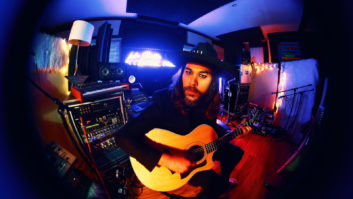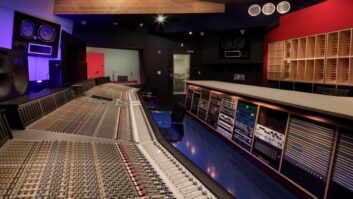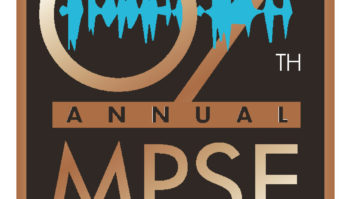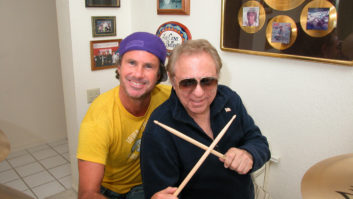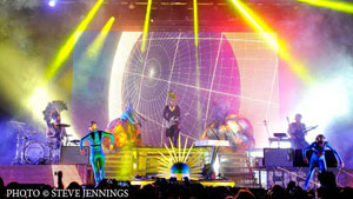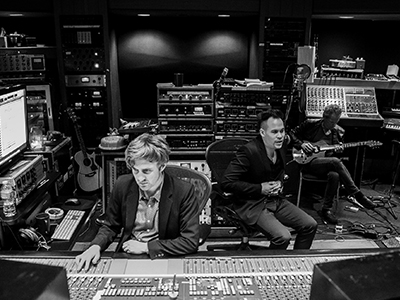
Empire of the Sun reigns across the city of Los Angeles. The group’s various studios do, anyway, stretching from downtown to Santa Monica. Each of the group’s central figures, Luke Steele and Nick Littlemore, plus its core creators, Peter Mayes and Jonathan (sometimes known as Donnie) Sloan, has his individual setup. Each member sketches in Ableton Live and records to Pro Tools, but all of them also have an affinity for boxes: tangible analog hardware in wood casing that looks dusty whether it actually is or not. This equipment is seemingly at odds with Empire of the Sun’s sound, which is super-shiny and fits very much into the current pop musical climate.
The group released their third album this year, the sophisticated Two Vines, which follows 2013’s glamorous Ice on the Dune and 2008’s pretty Walking on a Dream. Two Vines got its start while Empire of the Sun were working on the soundtrack to Dumb and Dumber To; the album was recorded in parts at Henson Recording Studios and at Island Sound Studios in Honolulu, Hawaii.
“Having done the film work, giving different elements to make it complete and needing to turn things around quickly, put us in a much more match-fit place,” says Littlemore, sitting with his longtime cohort Mayes in the latter’s spacious DTLA studio, where giant windows overlook the area’s historic Santee Alley.
“On Two Vines, any idea could be flipped or switched into something useful,” he continues. “We made a concerted effort on this album to bring it back to a warmer sound. It’s a bit more fragile and gentle, similar to the first album.”
Steele and Littlemore spent hours improvising vocal jams in Mayes’ studio, a practice that has become a blueprint of sorts for Empire of the Sun. It is a holdover from Littlemore’s and Mayes’ teenage years when they would play an incessant loop for hours on end, record it on cassette, listen back and cut out the best parts as a way of sampling themselves. Two microphones are set up with Steele and Littlemore flowing simultaneously, trying to find the ultimate melody and the right hook.

Lindsey Buckingham (center) shares ideas with Luke Steele, , Peter Mayes, Jonathan Sloan, and Nick Littlemore.
“It’s like tricking your brain to see in different patterns,” Steele explains from his cozy, gothic-themed, incense-scented studio just blocks from the beach. “We’ll record in different speeds through the song, or in a different key to what it will be laid down in. We’ll do four chords for like an hour and then replace the chords, and switch the melody to the new chords. You get into musical habits, but with this one, we went deeper.
There is a simple backing track over which Steele and Littlemore are vocal jamming, some of which is provided by Sloan, says he does his best work when he’s on his own. “My best ideas happen when I’m not trying to write,” he says in the temporary studio space of his scenic bird’s nest home in the Hollywood Hills. “You get two or three hours of creativity a day. I was trying to replicate a process that was true to our best work. I wanted to save my core great ideas, so it was exciting, hopefully, for everyone. When I first started making music, my idea was to combine my two favorite things: Fleetwood Mac and Daft Punk. I try to surprise myself and trick myself into new ideas, similar to what they do with lyrics.”
A practice that has been carrying over is using giant collections of vinyl, which are culled for their sounds to come up with ingredients for songs. Two boxes will be pored over to maybe find one loop of a vocal chant, which is then reversed, from which two bars are used to create a melody, and from that, a hook, about which Steele says, shaking his head, “We need to be excessive to be simple.”
Most members have a Yamaha CS-80—none of them in the best condition—but as Littlemore says, “That’s the keyboard sound of Empire of the Sun.” Drums come from both a live drummer, and from programming. Sloan has been using the same two snares and two kicks from the Oberheim DMX since he was 13. They live on his computer and, over the years, have been treated with various EQs and exciters; he also combines them with sounds from a Roland TR-808 and/or R-8.
“I think about emulating a live drummer rather than approaching it as a programmer,” says Sloan. “I recorded the bell of a ride cymbal into a Yamaha SV-12 on ‘Walking on a Dream,’ which I thought would be funny and kind of lame. The $300 guitar I played on it, I didn’t have a pick so I used my credit card. My CS-80 was badly out of tune for the whole first album. I just added more chorus. There are so many mistakes, but I love that about it.”
“It sounds pretty messy at times,” says Mayes. “If we have eight tracks to get some separation, we will mark bits and remake anything that sounds good from the jams. But sometimes, in those original recordings, when an idea comes through, it’s perfect in the moment and you can’t quite re-create it. Once you have all the bits, you try and arrange it to see if the sections flow. When you’re recording for an hour, you have so many different ideas at the same time, but they have to flow into a song.”
Stellar musicians such as keyboardist Henry Hey (“the human arpeggio,” says Mayes), bassist Tim Lefebvre, and Fleetwood Mac’s Lindsey Buckingham also helped select sounds for Two Vines. It’s the instantly identifiable vocal, however, that cements an Empire of the Sun song.

“[Steele] is singing his face off on this album,” says Mayes, who uses a Telefunken 250 microphone into Inward Connections Vac Rac 4000 mic pre, 4000 EQ and 4000 limiter for the vocal chain. “He has that midrange that is not easy to capture, and a lot of microphones can’t take it. It’s about finding a microphone that won’t distort, and a compressor and preamp that have the headroom to deal with the dynamics of his voice.
“We do a lot of layering and doubling, and sometimes the vocals are very ambitious,” Mayes continues. “We do a hard voice, soft voice, whisper, harmony. It could be 16 tracks from hundreds of tracks of vocals in the initial tracking.”
“I’m not a proper singer, I’m a character singer,” says Steele. “The way I translate a song is by tapping into that perfect character and feel for that song. [Mayes] understands that, which is crucial. If I’ve been surfing on the North Shore all day, coming into the studio off a bottle of rum, and being so relaxed with a summer breeze coming in, it’s a character. If that’s not the final vocal, trying to re-create that sucks because it’s so specific to my mood. It might take two weeks to find that again. There will be 30 tracks of vocals and we re-track it all again, maybe four times, until I’m in that character. It’s like panning for gold with my voice. But when it’s right, it’s amazing.”
